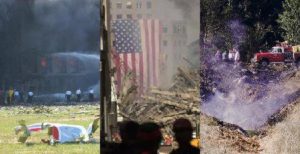More than 3,000 children never saw their parents again. On Jan. 6, Congress returned within hours.
Democratic lawmakers want to establish a “9/11-style commission” to investigate the siege of the Capitol on Jan. 6. “I would like to see Jan. 6 burned into the American mind as firmly as 9/11, because it was that scale of a shock to the system,” commentator George Will said recently. The attempt to reconfigure the “domestic terrorist” narrative to fit the horrifying story of Sept. 11 is profoundly disheartening. These two events are fundamentally different in nature, scope and consequences. Mentioning them in the same breath not only diminishes the horror of what happened on 9/11; it tells a false story to the generation of Americans who are too young to remember that day nearly 20 years ago.
My brother, Charles “Chic” Burlingame, was the pilot of American Airlines flight 77. He was murdered in his cockpit at age 51 in a 6½-minute struggle for control of the airplane. Here is what I want these young people to know:
Members of Congress might have had a frightening day on Jan. 6, but on 9/11 some 200 people in the World Trade Center towers chose to jump from 80 to 100 floors above the ground rather than be consumed by fire. A woman waiting at a lobby elevator bank was burned over 82% of her body when jet fuel from the first plane sent a ball of fire down the elevator shaft and into the lobby. She spent three months in a hospital burn unit and was permanently disfigured.
There are countless harrowing stories like this—of death, destruction and heartbreaking loss. More than 3,000 children lost parents. Eight young children were killed on the planes. Recovery personnel found 19,000 human remains scattered all over lower Manhattan from river to river, including on rooftops and window ledges. Victims’ remains were still being recovered years later by utility workers and construction crews. Some families received so many notifications of remains that they couldn’t take it any more and asked for them to stop. More than 1,100 families received nothing. Their loved ones went to work that morning and disappeared.
The attack brought down our nationwide aviation system, shut down the New York Stock Exchange for days, destroyed or rendered uninhabitable 16 acres of Lower Manhattan including underground subway and commuter train lines and destroyed a section of the Pentagon. Rebuilding at ground zero is still incomplete, and U.S. troops are still in Afghanistan.
On Jan. 6, Congress resumed its session that evening.
It is deeply offensive and sad that the brutal and harrowing memories of the worst terrorist attack in American history are being deployed by political partisans. They are using 9/11 not as an example of what the American people endured and overcame together, but explicitly to divide, to stoke hatred and to further a political agenda aimed at stigmatizing the other party and marginalizing ordinary Americans from participating in the political process. That is the real threat to democracy.
It should matter that the vast majority of the people who went to the Capitol protest that day didn’t believe they were there to overthrow the U.S. government, or, it must now be said, to kill anyone.
There have been real terrorist attacks on the Capitol. But those must be forgotten because they came from the political left. In 1971 the Weather Underground, a Marxist-Leninist terrorist group whose goal was the overthrow of the U.S. government through violent, armed revolution, blasted a hole through the ceiling on the Senate side of the complex. It also bombed the Pentagon in 1972 and the State Department in 1975.
In 1954, four Puerto Rican nationalists opened fire with automatic weapons from the House visitors gallery with members in the chamber for a quorum call. Five representatives were wounded, including one, Alvin Morell Bentley of Michigan, who was hit in the chest. The perpetrators received sentences ranging from 50 to 75 years; one was released in 1978, and President Carter granted clemency to the others the following year. One week after the shooting, the House was back to business as usual. That was a time when more members of Congress had served in the military, and with the world still recovering from World War II, one doubts that anyone likened the attack to Pearl Harbor or the Battle of Iwo Jima.
We are living in perilous times. When a modern democracy deploys forces of intimidation—whether government, corporate media or cultural institutions—to promote the ruling majority’s propaganda, it is time for good people to stand up and object. The world-changing attack of Sept. 11, 2001 shouldn’t be used, either as precedent or moral authority, to create a commission whose sole purpose is to turn a straightforward law-enforcement failure into destructive political theater.
Ms. Burlingame is a founding board member and trustee of the 9/11 Memorial and Museum Foundation and a director of the National Medal of Honor Museum Foundation.
This commentary by her first appeared on the Opinion Page of the Wall Street Journal on May 27, 2021, under the same title.

